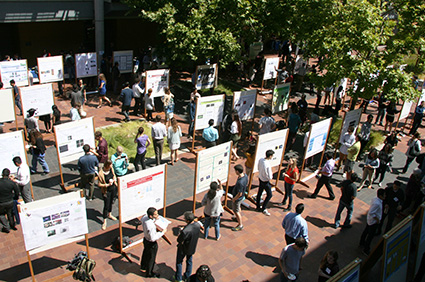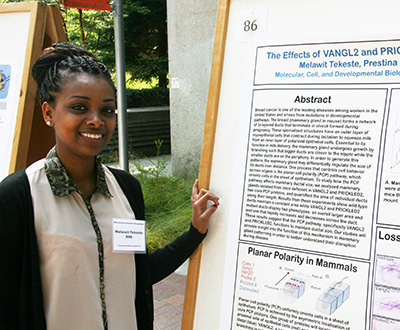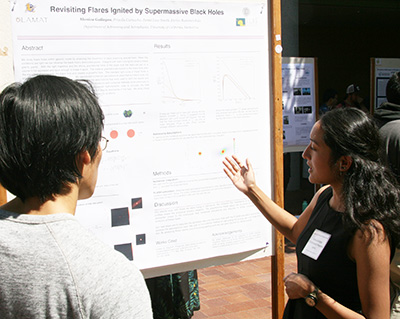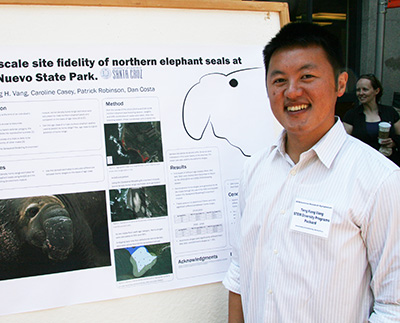More than 100 student research projects were featured at the seventh annual Summer Research Symposium held on Friday, August 12, in the Baskin Engineering Courtyard.
Student researchers explained their work to faculty, staff, and fellow students who gathered around the posters on display in the courtyard. Subjects included smart irrigation systems, Alzheimer's proteins, planet formation, genomic data management, renewable energy systems, supermassive black holes, and much more.
The undergraduate researchers presenting their work included UC Santa Cruz students in a broad range of disciplines, as well as students from regional community colleges and other institutions who came to UC Santa Cruz for research experience through various outreach programs.
Student researchers at UCSC receive support from a wide range of programs funded by the National Science Foundation (NSF), National Institutes of Health (NIH), the University of California, and gifts from UCSC alumna Julie Packard.
The Summer Research Institute (SRI) is an eight-week summer internship program where students are introduced to the theoretical and practical aspects of laboratory research. Under the guidance of UCSC faculty, students receive intensive laboratory and lecture courses in the methodology and concepts of modern biology and chemistry. Field trips and workshops prepare students for research experiences and applications for graduate school. Students participating in SRI come from various programs managed by the STEM Diversity Office in the Division of Physical and Biological Sciences.
Programs supporting student research at UC Santa Cruz include the following:
- The California Alliance for Minority Participation (CAMP) supports underrepresented students seeking degrees in science, mathematics, and engineering.
- The Initiative for Maximizing Student Development (IMSD), formerly known as the Minority Biomedical Research Support (MBRS) program, is funded through the NIH.
- The Maximizing Access to Research Careers (MARC) program is an honors program also funded through the NIH.
- The UC Leadership Excellence through Advanced Degrees (UC LEADS) program prepares undergraduates to earn advanced degrees in science, technology, engineering, and mathematics fields.
- The Lamat Summer Research Program is an eight-week summer program funded by the NSF Research Experiences for Undergraduates program and designed to introduce students to astrophysical research methods and tools through original research projects in computational astrophysics. Additional funding from Julie Packard increases the number of students in the Lamat program.
- ACCESS is an academic bridge program for community college students interested in pursuing a career in biomedical research science.
- The Hartnell Living Learning Community provides an inclusive and supportive community for Hartnell College STEM transfer students at UC Santa Cruz.
- The BD2K Summer Undergraduate Program at UCSC's NIH-funded Center for Big Data in Translational Genomics provides research opportunities for underrepresented students interested in genomic science from two partner institutions: California State University Monterey Bay and University of Puerto Rico-Río Piedras.






